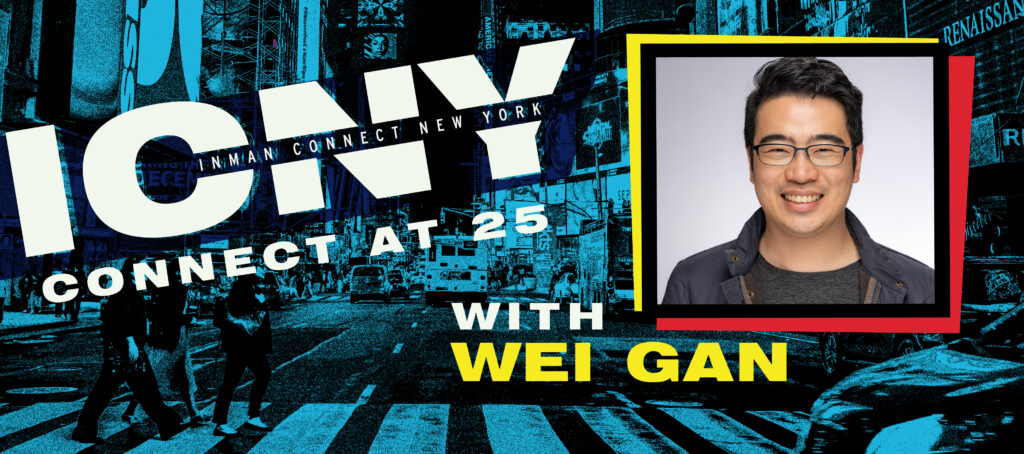Attend Inman Connect New York in person or virtually, April 19-21, to join thousands of successful producers who know what it takes to reach the top of the real estate game. Reserve your spot now to gain insights, make new connections that generate more referrals, and learn from the sharpest minds in the industry. Don’t wait — ticket prices will go up!
Power Buyer Ribbon expanded into the Midwest and Mid-Atlantic during the first quarter, as it seeks to make good on a vow to be up and running in 25 states by the end of the year. With home prices continuing to rise, Ribbon is also supporting home purchases of up to $1 million, up 43 percent from its previous limit.
Founded in 2017, Ribbon partners with real estate agents and lenders to make cash offers on behalf of buyers. Ribbon co-founder and Chief Technology Officer Wei Gan recently shared his thoughts with Inman about how Ribbon will pursue its mission of making homeownership more affordable in a market where prices keep going up.
Gan will be speaking about alternative financing models Tuesday, April 19 at Inman Connect New York.
This interview has been edited for length and clarity.
Inman: What do you make of this market? There’s some talk of a bubble, in terms of home price appreciation, but when you look at the underwriting, borrowers seem to be more solid in terms of credit scores and loan-to-value ratios than during the 2007-09 downturn.
Wei Gan: You see 15 percent to 20 percent home price appreciation, these year-over-year increases, and [your thoughts] immediately go back to the housing bubble, right? There’s absolutely a housing crisis in the United States, and there has been for a couple years. But it’s not a crisis of demand, or a bubble that’s gonna pop — it’s a supply crisis. There’s not enough homes.
As a nation we’re trying to build as best as we can. There’s more new housing starts, but the supply crisis is unfortunately not over. A lot of that is structural. A lot of it, depending on where you are, is about housing zoning policy. We also have a materials crisis, so that slows down building. I know personally, folks who have done home renovations, [who say] prices of lumber and so on have gone up. So the supply crisis is here to stay.
The reality is, there’s just more demand for first-time homeownership, and homeownership in general, than there’s supply for. The pandemic exacerbated that with the great relocation, the great dislocation — a lot of folks moving from San Francisco, New York, L.A. into a lot of secondary markets that Ribbon’s in. We see a lot of that pattern.
We recently spoke to a realtor in Texas, who said 90 percent of their clients — and this is Fort Worth right, not Austin, not Houston — 90 percent of their clients in Fort Worth were coming from out of state. So are home prices going to go up now 20 percent year over year? I don’t think that’s super healthy. I don’t think that’s great for affordability in the U.S. And so the supply crisis is unfortunately not over.
What do you see happening with home prices, interest rates and inventory? Interest rates were already heading up in anticipation of more Fed tightening, but the war in Ukraine has created additional economic uncertainty.
While the Fed was considering a 50 basis points rate hike [back in March], with the uncertainty around the world situation they made it very clear that they would not raise the federal funds rate by more than 25 basis points in March — they committed to that. They’ve also issued guidance that they are going to have a very data driven approach, right? [The Fed’s position is] not, ‘We’re committing to raising, raising, raising, and inflation is a problem.’ And I think that is a very wise move. Because with the uncertainty it’s unclear whether the right monetary policy for the U.S. is to jam on the brakes and increase rates, or raise them a little bit, or keep them stable, right? Or in some other scenarios, maybe print more money. And so I do appreciate that approach.
I think what you will see this year is, hopefully, the demand being less extreme than last year and the second half of 2020. That great dislocation, it should slow down, at least from a theoretical position — there’s still a lot of these movements around the U.S. Remote work is here to stay, right? Most of Ribbon’s team is not in New York or Charlotte, which are our headquarters. I think you will see when interest rates go up, demand will steady out. We will see home-price appreciation still be high, but hopefully not in that kind of 15 plus percent range. That’s completely unsustainable for affordability of housing in America.
I think at the lower price range, starter homes, the market dynamic there is that so much investment money has poured in. It started with Invitation Homes, and now there’s many, many other real estate funds. Every other hedge fund is pouring money into residential real estate. Why? Because they view it as a hedge against inflation, right? If they own residential real estate and the U.S. government prints money, home prices will go up.
What that results in is that the demand for homes at the starter price range is kind of insatiable. Because for the investor, they can buy that, they can turn around, they can rent it out, they can make yield and they can get home price appreciation, that kind of 10 percent year-over-year that we’re seeing, and every year rent goes up so the rental yield goes up, right? And that kind of creates a vicious cycle for consumers at that side of the price range.
Ribbon is now supporting home purchases of up to $1 million, a 43 percent increase from the previous limit of $700,000. Are the customers for these pricier homes move-up buyers, rather than first-time homebuyers?
We support buyers at every stage of life — first-time homebuyers, move-up buyers, and even the empty nesters downsizing or moving to a different area. So we want to make sure that we can help as many homebuyers as possible. Ribbon’s mission is to make homeownership achievable. Not just that first-time homeownership, but ownership of the home that you as a family, as a couple, as an individual, buy.
It’s funny — when you’re in New York or California, the first-time homebuyer is buying an $800,000 home at the very least, no question. We’re not in these markets right now. But the reality is last year’s $700,000 home is this year’s $900,000 home, right? Exact same home, exact same place. A home in Dilworth, which is a neighborhood in Charlotte [North Carolina], that was $700,000 last year is probably like $860,000 this year. So these are the same homes, and we’re just keeping up with the market in that sense.
Fannie Mae and Freddie Mac’s federal regulator increased the 2022 conforming loan limit to $647,200 this year, which was a record 18 percent increase. The limit is close to $1 million in higher-cost markets.
I think that’s what Fannie Mae and Freddie Mac are doing with the conforming loan limits — they’re just keeping up with the market. Same homes, we just keep up with inflation.
On the other side of this for us is, who is going after those? It is a lot of move-up buyers. At this point, the majority of homebuyers who come to Ribbon are first-time homebuyers. I’m very proud of that. But we believe that move-up buyers deserve the exact same level of service. They deserve the freedom to buy before you sell. And for a lot of the folks who are selling their current home, they have a ton of equity built up right across the last year. But they can’t buy their new home until they sell their current one, whether that’s debt-to-income ratios, most often it’s down payment. They need to be able to unlock that [equity] and they can totally afford that $800,000, $900,000 home. But they can only afford it when they sell.
This move-up buyer is truly caught in this Catch-22. And for us, it’s really important to unlock that piece for them because, if we think about helping that person, guess what? They’re selling their $600,000 home to another move-up buyer, or a first-time homebuyer, and that person buying that home is actually a first-time homebuyer, or selling a $300,000 home. Affordability is this kind of giant chain of events.
When Realtors talk to us, they describe this as a chain transaction. There’s like five different transactions that are going on at the exact same time, all contingent on something happening on another home. And often the very first home in there is a starter home for a first-time homebuyer, a $250,000 three-bed, two-bath in a nice neighborhood. And unfortunately that person who can’t get a mortgage on that $800,000 home results in that first-time homebuyer being completely unable to buy that $350,000 home. You’re breaking that chain because you’re stepping in providing certainty. We provide this to all the Realtors, to all the lenders, to everyone in the ecosystem that we’re open to and that ultimately then helps as many consumers as possible.
Ribbon recently expanded into the Midwest and the Mid-Atlantic, with the addition of Indiana, Missouri, Oklahoma and Virginia expanding Ribbon’s presence into 11 states. How do you choose where to provide your services?
So my co-founder, [Shaival Shah] is on the record with Inman that Ribbon vows to be in half the United States by the end of this year.
So part of that is kind of we’ve got to come through on our promise, right? Because how many of those Realtors are reading Inman that are based in Phoenix, Arizona, or they’re based in Ohio? And they’re like, ‘OK, Ribbon, you’ll be in half the states,’ right? Even Realtor friends I have in New Jersey, or New York, they’re like, ‘Come on, when you coming here, when you coming in here?’
So I do think we want to be everywhere and to be able to help as many Realtors, lenders and ultimately their clients — homebuyers — as possible. Part of what’s driving our strategy to be everywhere is partnerships — large partnerships with a lot of these national brokerages and lenders. So I think you’ll see, throughout the course of the year, a lot more from Ribbon.
And I think it elides really why we are different from the rest of the Power Buyer ecosystem. Where we’re different from the rest of the Power Buyers, and what we’re really trying to rally behind is this theme of, basically, ‘The Ecosystem Strikes Back.’
I think it ties into a lot of what Brad Inman has been talking about over the many years of Ribbon’s existence at this point, which is that, yes, there’s disruption coming, right? But the ecosystem of Realtors, lenders, local loan officers, local brokerages, local teams — they add so much value. And the ones that adapt really well for the future will not just continue to be there but they will thrive.
Email Matt Carter



 Are You Interested in West Eleventh Residences Miami?
Are You Interested in West Eleventh Residences Miami? Are You Interested in ONE Park Tower by Turnberry?
Are You Interested in ONE Park Tower by Turnberry? Are You Interested in Diesel Wynwood Condominium?
Are You Interested in Diesel Wynwood Condominium? Are You Interested in Five Park Miami Beach?
Are You Interested in Five Park Miami Beach? Are You Interested in Cipriani Residences Miami?
Are You Interested in Cipriani Residences Miami? Are You Interested in Bentley Residences Miami?
Are You Interested in Bentley Residences Miami? Are You Interested in Baccarat Residences Brickell?
Are You Interested in Baccarat Residences Brickell? Are You Interested in Aria Reserve Miami?
Are You Interested in Aria Reserve Miami? Are You Interested in 888 Brickell Dolce & Gabbana | Miami?
Are You Interested in 888 Brickell Dolce & Gabbana | Miami? Are You Interested in 600 Miami WorldCenter?
Are You Interested in 600 Miami WorldCenter? Are You Interested in HUB MIAMI RESIDENCES?
Are You Interested in HUB MIAMI RESIDENCES? Are You Interested in WALDORF ASTORIA RESIDENCES?
Are You Interested in WALDORF ASTORIA RESIDENCES?